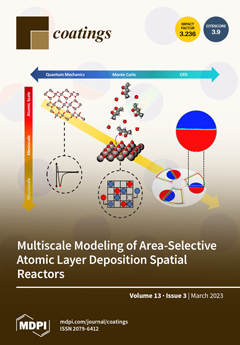Hexagonal ZrB
2 belongs to the group of ultra-high temperature ceramics representing an important class of materials with the potential to meet the high demands of today’s industry. However, this potential is limited by inherent brittleness and poor tribological properties. Here, the combination
[...] Read more.
Hexagonal ZrB
2 belongs to the group of ultra-high temperature ceramics representing an important class of materials with the potential to meet the high demands of today’s industry. However, this potential is limited by inherent brittleness and poor tribological properties. Here, the combination of density functional theory and experiment is used to investigate the effect of silver alloying on the mechanical and tribological properties of hexagonal ZrB
2 thin films. Calculations indicate strong insolubility of Ag atoms in the ZrB
2 metal sublattice and a significant effect on the mechanical properties, pointing out an improvement in ductility and tribological properties but at the cost of reduced hardness. The experiments confirmed the theoretical predictions of the strong insolubility of silver, where the magnetron-sputtered Zr
1−xAg
xB
2+Δ films form a segregated nanostructure consisting of separated hexagonal ZrB
2 and cubic Ag phases. With increased Ag content, values of Young’s modulus decrease from E
ZrB2.31 = 375 GPa to E
Zr0.26Ag0.74B0.89 = 154 GPa, followed by a decrease in hardness from H
ZrB2.31 = 30 GPa to a value of H
Zr0.26Ag0.74B0.89 = 4 GPa. The suppression of crack formation is also shown with the material flow around cube corner indents, indicating enhanced ductility. The improvement of tribological properties was also confirmed when the coefficient of friction (COF) was reduced from COF
ZrB2.31 ~0.9 to a value of COF
Zr0.26Ag0.74B0.89 ~0.25 for all counterpart materials—steel (100Cr6), Si
3N
4, and WC/Co.
Full article





